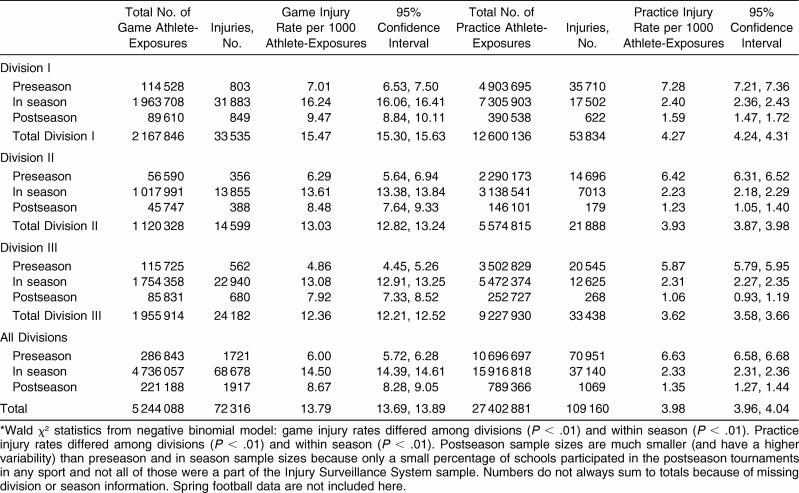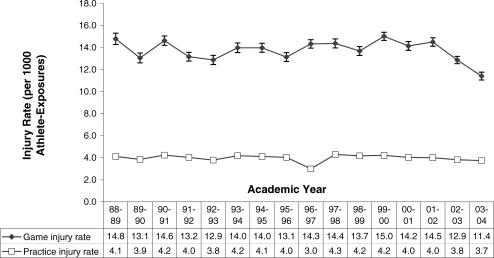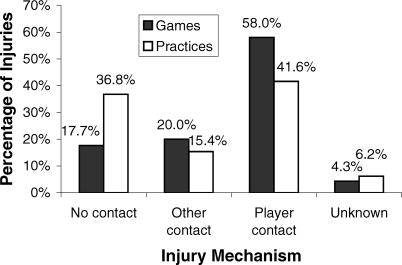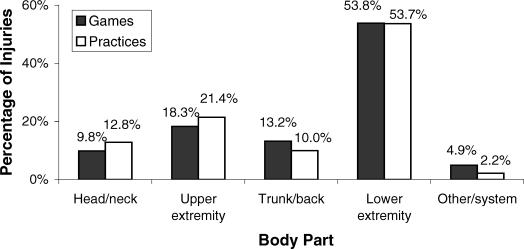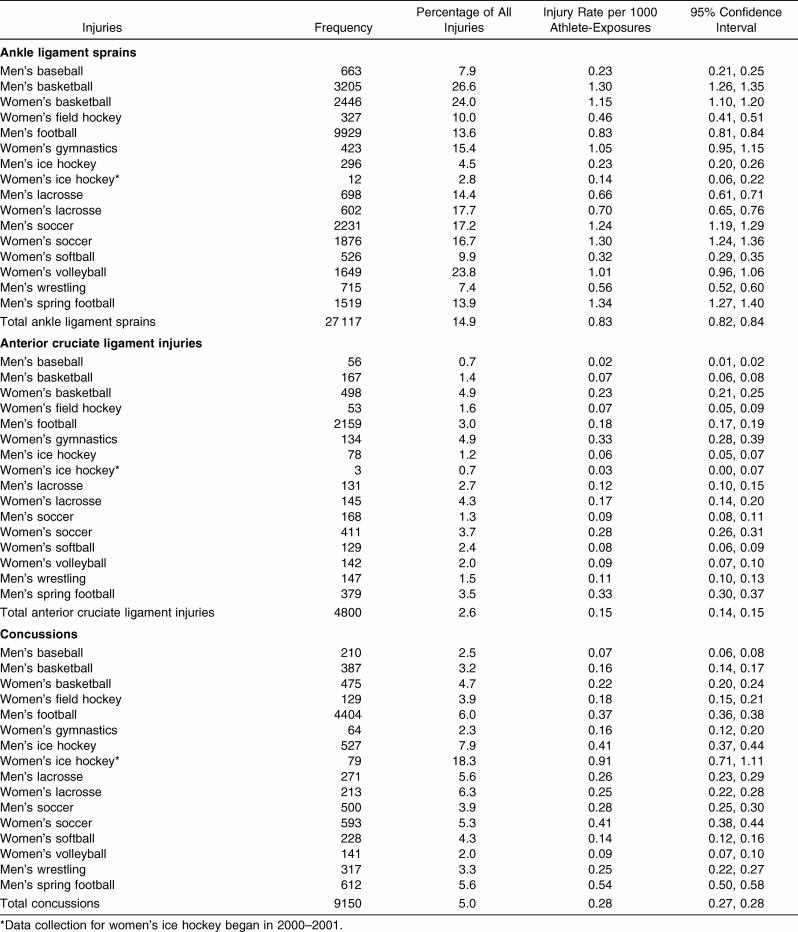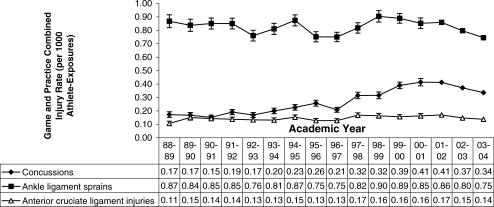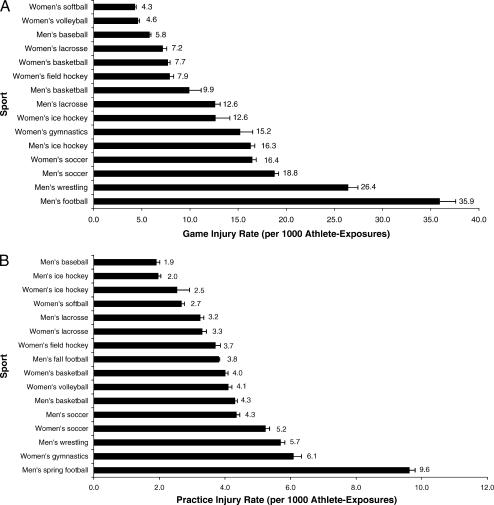Abstract
Objective: To summarize 16 years of National Collegiate Athletic Association (NCAA) injury surveillance data for 15 sports and to identify potential modifiable risk factors to target for injury prevention initiatives.
Background: In 1982, the NCAA began collecting standardized injury and exposure data for collegiate sports through its Injury Surveillance System (ISS). This special issue reviews 182 000 injuries and slightly more than 1 million exposure records captured over a 16-year time period (1988–1989 through 2003–2004). Game and practice injuries that required medical attention and resulted in at least 1 day of time loss were included. An exposure was defined as 1 athlete participating in 1 practice or game and is expressed as an athlete-exposure (A-E).
Main Results: Combining data for all sports, injury rates were statistically significantly higher in games (13.8 injuries per 1000 A-Es) than in practices (4.0 injuries per 1000 A-Es), and preseason practice injury rates (6.6 injuries per 1000 A-Es) were significantly higher than both in-season (2.3 injuries per 1000 A-Es) and postseason (1.4 injuries per 1000 A-Es) practice rates. No significant change in game or practice injury rates was noted over the 16 years. More than 50% of all injuries were to the lower extremity. Ankle ligament sprains were the most common injury over all sports, accounting for 15% of all reported injuries. Rates of concussions and anterior cruciate ligament injuries increased significantly (average annual increases of 7.0% and 1.3%, respectively) over the sample period. These trends may reflect improvements in identification of these injuries, especially for concussion, over time. Football had the highest injury rates for both practices (9.6 injuries per 1000 A-Es) and games (35.9 injuries per 1000 A-Es), whereas men's baseball had the lowest rate in practice (1.9 injuries per 1000 A-Es) and women's softball had the lowest rate in games (4.3 injuries per 1000 A-Es).
Recommendations: In general, participation in college athletics is safe, but these data indicate modifiable factors that, if addressed through injury prevention initiatives, may contribute to lower injury rates in collegiate sports.
Keywords: athletic injuries
S ince 1988, the National Collegiate Athletic Association (NCAA) Injury Surveillance System (ISS) has collected injury and exposure data from 16 sport activities: men's baseball, men's basketball, women's basketball, women's field hockey, men's fall football, men's spring football, men's gymnastics, women's gymnastics, men's ice hockey, men's lacrosse, women's lacrosse, men's soccer, women's soccer, women's softball, women's volleyball, and men's wrestling. Data collection for a 17th sport, women's ice hockey, began in the 2000–2001 season. Men's gymnastics is not included due to small sample size, and fall and spring football are reported in the same article. A total of 182 000 injuries and slightly more than 1 million exposure records are contained in the sample from 1988–1989 through 2003–2004 described in this special issue. This article will summarize selected information from the 15 individual sport activities to provide an overview of general injury trends in college athletics. We also highlight injury rates for 3 specific conditions across all sports: ankle ligament sprains, anterior cruciate ligament (ACL) injuries, and concussions.
A reportable injury in the ISS had to meet all of the following criteria: (1) injury occurred as a result of participation in an organized intercollegiate practice or contest; (2) injury required medical attention by a team certified athletic trainer or physician; and (3) injury resulted in restriction of the student-athlete's participation or performance for one or more days beyond the day of injury. An exposure was defined as 1 athlete participating in 1 practice or game (athlete-exposure, A-E), and injury rates were expressed as the number of injuries per 1000 A-Es. More detail regarding the sports covered, sampling methods, and case definitions can be found in the “Introduction and Methods” article in this special issue. 1
Over the 16-year sample period, injury trends may have been influenced by a variety of factors, including increased athletics participation, changes in NCAA rules and policies, and the continued evolution of the practice of sports medicine. Participation has increased among both sexes (80% increase in females and 20% increase in males) in all NCAA championship sports. The NCAA policy changes have been sport specific (eg, mandating eye protection in women's lacrosse, changing the weight classes in wrestling), division specific (eg, modifications to spring football practice in Divisions I and II), and across all divisions (eg, expanding the number of games in a season, increasing the length of practice seasons, and expansion of postseason tournament qualifying fields). Medical coverage for college athletics has improved, particularly with the creation of the 2000 National Athletic Trainers' Association (NATA) “Recommendations and guidelines for appropriate medical coverage in intercollegiate athletics.” 2 The NATA reports that the number of certified athletic trainers working in the collegiate setting has increased 86% over the last 10 years (from 2654 in 1995 to 4947 in 2005; NATA, unpublished data, 2007). Finally, the field of sports medicine has advanced over this time, particularly with regard to evidence-based interventions (eg, bracing, physical conditioning programs) and medical awareness and diagnosis (eg, heightened awareness and ability to assess concussions).
In the following section, we first report selected results summarized across years and, in most cases, across sports and divisions. After each set of results, we provide commentary that addresses potential related prevention initiatives.
DATA SUMMARY AND COMMENTARY
Overall Game and Practice Injury Rates
Table 1 shows overall game and practice injury rates by division and season, combined across 15 sports. The seasonal injury rates in both games and practices show similar patterns across divisions. For games, preseason competition accounted for the lowest injury rate in all divisions (6.0 injuries per 1000 A-Es, 95% confidence interval [CI] = 5.7, 6.3), whereas the in season was associated with the highest game injury rates (14.5 per 1000 A-Es, 95% CI = 14.4, 14.6). Rates in the postseason were significantly higher than those in the preseason (8.7 versus 6.0 per 1000 A-Es) but significantly lower than those in the regular season (14.5 per 1000 A-Es). Division I had the highest rates and Division III the lowest, regardless of season; however, not all differences were statistically significant.
Table 1. Game and Practice Injury Rates, 15 Sports, National Collegiate Athletic Association, 1988–1989 through 2003–2004.
For practices ( Table 1), preseason practices accounted for the highest injury rate (6.6 per 1000 A-Es, 95% CI = 6.6, 6.7) across all divisions, whereas the postseason had the lowest practice injury rates (rates ranged from 1.1 per 1000 A-Es in Division III to 1.6 per 1000 A-Es in Division I). Within each Division and overall, preseason practice injury rates were 2.5 to 3 times higher than in-season practice rates and 4.6 to 5.5 times higher than postseason practice rates. As was the case with game rates, practice injury rates were highest in Division I and lowest in Division III, regardless of season.
Across all divisions and seasons, the rate of game injuries (13.8 per 1000 A-Es, 95% CI = 13.7, 13.9) was 3.5 times higher than the rate of practice injuries (4.0 per 1000 A-Es, 95% CI = 3.9, 4.0). These rates equate to 1 injury every 2 games and 1 injury every 5 practices for a team of 50 participants.
Significant variability exists across sports for the “intensity” of both game activities and, particularly, practice activities. Quantifying this variable is an important research opportunity that could aid future injury prevention research. In general, the higher “intensity” of game activity, in nonquantifiable terms, is most likely an important contributor to the higher injury rates in games compared with practices.
A variety of reasons may explain why injury rates are higher during the preseason than during other parts of the sport season. Some athletes may come to the preseason poorly conditioned, and, thus, the stress of the high-intensity, high-load preseason training may result in an excess of injuries. Also, any given preseason practice often lasts longer than an in-season or postseason practice. Because an ISS exposure has no time component, an individual is at a higher risk of injury in a longer practice because of the extended exposure to athletic activity. Future authors who use a finer level of exposure measurement, such as player-minutes, may be better able to discriminate among these possible seasonal differences in injury rates. However, it should be noted that this more detailed exposure measurement (player-minutes) may be extremely difficult or impractical to obtain given the time and effort it would take to gather these data. Preseason practice also often includes multiple practices on the same day; this scenario may limit recovery for subsequent activities and pose a higher injury risk to players. Preseason practices also may have more less-skilled or “walk-on” persons trying out for the sport; such individuals may be more susceptible to injury. Preseason is also a time when all players may be competing for starting positions, thus creating a highly competitive atmosphere, which may increase injury rates. Many of the listed seasonal factors may be modifiable, so the potential is great for developing injury prevention interventions to address the high rates of preseason injuries. Preseason competition injury rates were lower than in-season or postseason competition rates. This finding is likely due to the fact that preseason competitions in most sports may be more like scrimmages or practice games. Coaches may be using players in different combinations than during the regular season, and the intensity of play may be somewhat mitigated compared with regular-season competitions.
Injury prevention strategies, such as phased-in, multiple-day practices; modifying practice times to accommodate environmental conditions; mandating appropriate recovery time; and preparticipation medical examinations, should be developed and implemented to reduce preseason injury rates. In 2003, the NCAA created legislation to address heat illness and general injury in preseason football practices. This policy mandated a 5-day acclimatization period and other practice time limitations during the preseason training session. 3 Initial feedback from both coaches and players was generally favorable, although it is too early to quantify the effect on preseason heat or general injury rates. The American College of Sports Medicine has followed up on this NCAA policy with a 2004 expert panel roundtable, “Youth football: heat stress and injury risk,” 4 expanding the conversation to youth sports and setting the stage for discussions across multiple sports. Minimizing preseason injury rates in all sports through basic concepts of recovery and hydration, as well as through more innovative ideas, represents an important area in which certified athletic trainers can make a difference.
Time Trends in Game and Practice Injury Rates
Figure 1 shows time trends in game and practice injury rates from 1988–1989 to 2003–2004 for all the 15 sports combined. Time trends show that game injury rates varied somewhat from 1988–1989 through 1995–1996 and leveled out for the remaining years, while practice injury rates demonstrated a more stable course. No statistically significant increases or decreases in game ( P = .78) or practice ( P = .70) injury rates occurred over the 16-year sample period.
Figure 1. Game and practice injury rates, 15 sports, National Collegiate Athletic Association, 1988–1989 through 2003–2004. Game time trend P = .78. Average annual change = −0.3% (95% confidence interval = −2.5, 1.9). Practice time trend P = .70. Average annual change = −0.2% (95% confidence interval = −1.4, 0.9) .
Although not statistically significant, visual trends indicate decreasing game injury rates over the 16 years, particularly in the last 2 academic years. This finding may be related to the modifications associated with NCAA policy and general sports medicine practice discussed in the “Introduction and Methods” article. 1 In particular, many of the specific NCAA rules modifications made over this time period were specifically focused on game situations (eg, clipping in football, hitting from behind in ice hockey). If such policies achieved some level of success in the applicable sport, the resulting injury trends may eventually be reflected in these data. It also is possible that the steady increase in the number of schools participating in the ISS over the sample period has contributed to a stabilization of game injury rates by effectively increasing the sample size over time.
Injury Mechanism
Figure 2 shows practice and game injury mechanisms for the 15 sports combined across years. For both practices and games, player contact accounted for the majority of injuries (58.0% in games, 41.6% in practices). In practices, noncontact injury mechanisms account for 36.8% of all injuries, compared with only 17.7% in games.
Figure 2. Distribution (percentage) of injuries by injury mechanism for practices and games, 15 sports, National Collegiate Athletic Association, 1988–1989 through 2003–2004.
Player contact is a normal part of some sports, such as football, men's ice hockey, men's lacrosse, and wrestling. However, as noted earlier, although the percentages of player contact injuries may be somewhat similar between practices and games, the overall practice injury rate in these contact sports may be significantly lower because of the judicious use of player contact in practice. Sport rules and policies that promote safer forms of player contact can be instituted and enforced. For example, the no-spearing and no-clipping rules were instituted in an effort to reduce contact-related injury rates (specifically head and neck injuries and knee injuries) in football. The no-spearing rule was thought to be such an important part of the game that the 2006 NCAA Football Division I Manual 3 listed it in the opening “Points of Emphasis” section, as well as under the code of ethics for coaches. Protective equipment, such as face guards in men's ice hockey and protective devices for injured body parts, also can be effective in minimizing player and apparatus contact injuries. Athletic trainers continue to play a leading role in creating innovative protection for susceptible body parts that allow players to participate with a reduced risk of injury from a direct blow.
Sports that limit or restrict player contact, such as soccer, basketball, and women's ice hockey, still have a majority of their game injuries associated with player contact. A review of playing rules in these sports to determine the effectiveness of the noncontact emphasis seems warranted.
The high percentage of practice noncontact injuries primarily reflects muscle strains and joint sprains that, for the most part, cannot be effectively addressed by formal NCAA legislation. Most of these noncontact practice injuries would best be addressed by identification and modification of risk factors. Just by being present and observing practices, athletic trainers may be able to identify and remedy potential injury-causing situations (eg, wet floors, environmental conditions). Future researchers should investigate the circumstances and characteristics of these noncontact practice injuries in more detail to identify possible injury prevention initiatives.
Distribution of Injuries by Body Part
Figure 3 shows the distribution of injuries by body part for practice and games, for 15 sports, combined across years. The distribution of injuries by body part was similar for both practices and games. More than 50% of all reported injuries were to the lower extremity in both practices and games, with knee and ankle injuries accounting for most of the lower extremity injuries (data not shown). Injuries to the upper extremity accounted for 18.3% and 21.4% of game and practice injuries, respectively.
Figure 3. Distribution (percentages) of injuries by body part for games and practices for 15 sports, National Collegiate Athletic Association, 1988–1989 through 2003–2004.
In terms of total burden in the athletic population, the preponderance of injuries to the lower extremity justifies particular emphasis in athletic training education and prevention efforts in this area. Although studies targeted to minimize injury to particular joints (ankles) or structures (ACLs) have merit, more attention should be directed to injury prevention research that is applicable to all types of lower extremity injuries. Identifying modifiable risk factors that are common to the majority of lower extremity injuries and targeting injury prevention interventions to the populations that have the greatest need (eg, highest incidence or prevalence, those who are disproportionately affected) should result in noticeable reductions in injury rates and, possibly, reductions in related medical costs over time. This approach also may be scientifically stronger, because it is extremely difficult and expensive (since very large sample sizes and long follow-up times are needed) to conduct randomized controlled trials of injury prevention interventions for conditions that are relatively rare (eg, noncontact ACL injuries). For example, much of the research on neuromuscular exercise training programs for ACL injury prevention may have applicability to other conditions, such as ankle ligament sprains, 5, 6 hamstring injuries, 7 and lower extremity injuries in general. 8–10 There is a critical need to train researchers in the appropriate methods and to increase funding for injury prevention research in the United States. The NCAA ISS is an ongoing, flexible, and standardized injury surveillance tool that can be a valuable resource for such studies.
Rates of Select Injuries (Ankle Ligament Sprains, Anterior Cruciate Ligament Injuries, and Concussions) by Sport
Table 2 shows the frequency, distribution, and rates of select injuries (ankle ligament sprains, ACL injuries, and concussions), broken out by the 16 sports, combined across years. More than 27 000 ankle ligament sprains were reported over the 16 academic years, yielding an average of approximately 1700 per year. Assuming the sample represents approximately 15% of the total population of NCAA institutions, this equates to an annual average of more than 11 000 ankle sprains in these 15 activities. These injuries accounted for approximately one quarter of all injuries in men's and women's basketball and women's volleyball. However, spring football (1.34 per 1000 A-Es) and men's basketball (1.30 per 1000 A-Es) had the highest rates of ankle ligament sprains.
Table 2. Frequency, Distribution, and Rates of Select Injuries (Ankle Ligament Sprains, Anterior Cruciate Ligament Injuries, and Concussions) for Games and Practices Combined for 15 Sports, 1988–1989 to 2003–2004.
Approximately 5000 ACL injuries were reported over the 16 years, an average of 313 per year in this sample. Assuming the sample represents approximately 15% of the total population, this equates to an annual average of more than 2000 ACL injuries in these 15 activities. Football had the highest number of reported ACL knee injuries (2159 in fall and 379 in spring, 53% of all recorded ACL injuries), but women's gymnastics had the highest rate (0.33 per 1000 A-Es), equal to the rate for spring football (0.33 per 1000 A-Es). Three of the 4 sports with the highest rates were women's sports (gymnastics, basketball, and soccer), and, along with spring football, all had significantly higher ACL injury rates than any other sport.
More than 9000 concussions were reported over the 16 years, an average of 563 per year in this sample. Assuming the sample represents approximately 15% of the total population, this equates to an annual average of about 3753 concussions in these 15 activities. Football had the highest number of reported concussions (fall and spring combined, n = 5016, 55% of all concussions recorded), but women's ice hockey had the highest rate (0.91 injuries per 1000 A-Es, 95% CI = 0.71, 1.11; significantly higher than for all other sports). However, we caution that the ISS has collected data from women's ice hockey for only 4 years, and therefore data must interpreted with caution. Women's soccer, traditionally a noncontact sport, also had a relatively high rate of concussions (0.41 per 1000 A-Es, 95% CI = 0.38, 0.44).
Time Trends in Injury Rates for Select Injuries
Figure 4 shows time trends in injury rates for select conditions (ankle ligament sprains, ACL knee injuries, and concussions), combined across the 15 sports and combined across years. Time trends in the rates of reported ankle ligament sprains across sports appear relatively stable, with a nonsignificant decrease (−0.1%, P = .68) noted over 16 years. Rates of ACL injuries and concussions both demonstrated significant increases (ACL: 1.3% average annual increase, P = .02; concussion: 7.0% average annual increase, P < .01) over time. The rates of concussions doubled from 0.17 per 1000 A-Es in 1988–1989 to 0.34 per 1000 A-Es in 2003–2004. The observed upward trend in the concussion rate undoubtedly reflects improvements in the detection and management of concussion over the 16-year study period (especially in football) but may also represent some true increases in concussion rates over time.
Figure 4. Injury rates for select conditions (concussions, ankle ligament sprains, and anterior cruciate ligament injuries) for games and practices combined for 15 sports, National Collegiate Athletic Association, 1988–1989 through 2003–2004. Ankle ligament sprains time trend P = .68. Average annual change = −0.1% (95% confidence interval = −0.8, 0.5). Anterior cruciate ligament (ACL) injury time trend P = .02. Average annual change = 1.3% (95% confidence interval = 0.2, 2.4). Concussion time trend P < .01. Average annual change = 7.0% (95% confidence interval = 5.4, 8.7) .
Ligamentous injuries to the ankle are the most common injury occurring, regardless of sport or exposure type (game or practice), a fact supported in the literature. 11 In this sample, ankle ligament injuries represented 14.8% of all reported injuries (range = 3% [women's ice hockey] to 26% [men's basketball]). Marchi et al 12 reported in 1999 that 23% of ankle sprains in their study of moderate to severe sports injuries among children aged 6 to 15 years resulted in permanent sequelae over 12 years of follow-up. Although only 1 in 5 ISS ankle ligament injuries resulted in 10+ days of time loss (a marker of injury severity), if even a small proportion of these injuries result in long-term morbidity or disability, then they represent a large potential burden in the population.
Effective interventions exist that can reduce the incidence of ankle injury without critically impairing performance. 5, 13, 14 Prophylactic bracing or taping and neuromuscular/balance exercise programs can reduce the rate of lower extremity injuries by as much as 50%. 5 These interventions are particularly efficacious among athletes with a prior history of ankle injury. Specifically looking at the sport of volleyball, ankle sprain prevention programs have been proven efficacious and cost effective. 6, 15, 16 Because the majority of lower extremity sports injuries occur to the ankle, it is reasonable to think that these interventions, if broadly implemented, could reduce the incidence of ankle injury and/or reinjury. Despite this likelihood, no existing “best practice” or clinical practice guidelines direct the broad uptake of these interventions in the sports medicine community.
Overall, ACL injuries, regardless of mechanism, only accounted for approximately 3% of all injuries (range: 0.7% [women's ice hockey, men's baseball] to 5% [women's gymnastics, women's basketball]), but 88% of these injuries resulted in 10+ days of time loss. The rate of ACL injury increased 1.3% per year on average over the sample period. Evaluation of this injury trend over time also must include consideration of the significant changes in conditioning, bracing, and medical technology and diagnosis discussed earlier. The intense interest focused on ACL injuries—in particular, the noncontact ACL sex differences reported previously, 17, 18 which continue to be substantiated in this sample period—may have contributed to increased detection of these injuries. In conjunction with the increased clinical awareness of these injuries is the increased use and sensitivity of adjunct diagnostic tools such as arthrograms and magnetic resonance imaging. Although serious (as measured by time loss, pain, disability, and costs) in terms of both frequency and rates, ACL injuries are not “epidemic.” In fact, using the standard of <.05 as rare, the actual probability of ACL injury would be considered a rare event. For example, in 2003 Uhorchak et al 19 reported the probability of noncontact ACL injury during club and varsity sports at the US Military Academy to be 1 in 25 782 hours of exposure (probability, <.0001). The ACL injury rates in these NCAA data range from 0.02 to 0.33 per 1000 A-Es, depending upon the sport, which also indicates that ACL injuries are relatively rare. Contrast this with the ankle ligament sprain rates discussed above (range: 0.14 to 1.34 per 1000 A-Es); all but 4 sports (men's ice hockey, women's ice hockey, men's baseball, and women's softball) had ankle ligament sprain rates that were higher than that associated with the sports with the highest ACL injury rate (women's gymnastics and men's spring football). One interpretation of these data, as noted previously, is that injury prevention research should focus more on lower extremity injuries in general and not just on injuries to specific anatomical structures. This approach would require, however, that we establish risk factors that are common to all (or most) lower extremity injuries and develop interventions to address these factors.
Concussions represented 5% (women's volleyball) to 18% (women's ice hockey) of reported injuries, 14% of which restricted participation for 10 days or more (range: 2%). The rate of concussion increased significantly by 7% on average over the 16 years covered in this report, despite sport-specific efforts (eg, in ice hockey and men's lacrosse) to address the rising risk. This trend may reflect an actual increase in the numbers of concussions per unit of exposure, but it is also attributable, at least in part, to improvements in the identification of concussion (better awareness and diagnosis) in recent years. Even mild traumatic brain injuries may have long-term effects; therefore, it is critically important to identify potential prevention interventions for this injury. Promising areas of research include baseline neuropsychological testing for identification and helmet and mouthguard design for prevention. Collins et al 20 recently reported that newer models of football helmets (eg, the Riddell Revolution, Elyria, OH) may protect players from concussion. More research is needed in these areas, as well as in the area of injury biomechanics in ice hockey and lacrosse, to maximize the potential beneficial effect of concussion identification and prevention in all sports. Sex differences in the susceptibility to concussions in similar sports (such as soccer and basketball in this issue) may be another area for future research and prevention.
Game and Practice Injury Rates, by Sport
Figure 5 shows game and practice injury rates for 15 sports (fall and spring football are listed separately for practices; only fall football is listed for games) combined across years.
Figure 5. Overall (A) game and (B) practice injury rates for 15 sports, National Collegiate Athletic Association, 1988–1989 to 2003–2004. Although data for 15 total sports are presented, fall and spring football are reported separately for practices; because no “official games” are played during spring football, only fall football is listed for games.
For games, football had the highest rate of injury in games (35.9 per 1000 A-Es), followed by wrestling (26.4 per 1000 A-Es). Baseball had the lowest game injury rate (5.8 per 1000 A-Es) among men's sports. Among women's sports, soccer (16.4 per 1000 A-Es) had the highest game injury rate (fourth highest overall) and women's softball the lowest (4.3 per 1000 A-Es).
For practices, spring football had the highest rate of practice injuries (9.6 per 1000 A-Es), followed by women's gymnastics (6.1 per 1000 A-Es), wrestling (5.7 per 1000 A-Es), and women's soccer (5.2 per 1000 A-Es). The sports with the lowest rates of practice injuries were men's ice hockey (2.0 per 1000 A-Es), women's ice hockey (2.5 per 1000 A-Es), and men's baseball (1.9 per 1000 A-Es).
In sports traditionally associated with player contact, such as football, men's ice hockey, men's lacrosse, and even wrestling, the dramatic difference in the practice injury rate versus the game injury rate may be a reflection of curtailed contact in practice activities. In particular, men's ice hockey has the same sharp skates, wooden sticks, and high-speed pucks flying around during both practices and games; however, the player contact is reduced, contributing to a practice injury rate (2.0 injuries per 1000 A-Es) more than 8 times lower than the game injury rate (16.3 injuries per 1000 A-Es). The sports that are not traditionally associated with significant player contact do not have such dramatic differences between practice and game injury rates (eg, women's volleyball, baseball, and softball). The limiting of player contact with teammates in practice may be an important modifiable factor that, along with the concept of effectively quantifying the intensity variables, as noted above, warrants more research. Two typically noncontact sports, women's soccer and women's gymnastics, had injury rates in the range reported for contact sports such as wrestling (practices) and men's ice hockey (games). These data indicate that identifying risk factors for injury and implementing injury prevention interventions should be a high priority in these activities.
The ISS data also provide a foundation for informed institutional decision making with regard to staffing activities. Although individual school injury rates are the optimal resource, these national data can allow a sports medicine professional to make decisions regarding where to place limited staff during simultaneous events based on the risk of injury, a basic foundation of the NATA guidelines discussed previously. 2 By virtue of its limited and defined practice period, spring football was the only “nontraditional season” activity monitored in this sample. However, the finding of a spring practice injury rate that is almost 3 times higher than the fall football practice injury rate raises concern about why student-athletes appear to be at significantly higher risk for injury in “nontraditional” activities compared with in-season activities. Future research and prevention efforts should be directed to out-of-season activities in all sports.
CONCLUSIONS
The lower extremity accounted for more than one half of all reported injuries in this sample, justifying particular emphasis on this region in athletic training education, clinical practice, and prevention efforts. Ankle ligament sprains seem to be a common problem in all levels of college athletics, as they make up 14.8% of all injuries reported in the ISS. Concussions and ACL injuries were other high-profile injuries that occurred with less frequency but often carry more significant health consequences. The rates of these latter 2 injuries, particularly concussions, have significantly increased over the sample period. This increase may represent a combination of an actual increase in occurrences as well as a greater awareness of the symptoms and consequences associated with the injury (eg, detection bias). Prevention efforts may be more effective in terms of both numbers affected and costs if they are directed toward a larger number of general lower extremity injuries and not to specific low-incidence injuries, such as noncontact ACL injuries.
With the majority of game and practice injuries associated with player contact, prevention initiatives should focus on instituting and enforcing existing playing rules and policies developed for competitions. This is most likely the role of governing bodies such as the NCAA. Injury prevention issues related to practices, on the other hand, may be better monitored at the institutional level. The model recently adopted for preseason football practices, which involves gradual integration of full-contact practices with appropriate recovery time between sessions, is an example of a policy that may benefit other sports. 3, 21 Out-of-season and “nontraditional” season practice activities may be another area for intervention if the pattern of high spring (out-of-season) football injury rates, relative to the rates of fall practice, is similar in other sports.
In conclusion, these data indicate that the risk and rate of injury in intercollegiate athletics are relatively low (1 injury every 2 games and 1 injury every 5 practices for a team of 50 participants) and that most reported injuries do not result in substantial time loss (ie, they are minor-severity to moderate-severity injuries). Most importantly, these data highlight potentially modifiable factors that, if addressed through injury prevention initiatives, may be able to reduce injury rates in collegiate sports even further. Using the 4-step injury prevention model proposed by van Mechelen et al, 22 in which we (1) identify the problem, (2) establish etiology and mechanisms, (3) develop, evaluate, and implement interventions, and (4) reevaluate the effect via continued surveillance, the ISS is perfectly positioned to assist with the first and last steps of this process. The ISS can also be used to (1) guide informed decision making regarding issues such as appropriate medical care staffing and sport-specific safety, (2) identify naturally occurring injury rate peaks and valleys, (3) identify new emerging issues (eg, methicillin-resistant Staphylococcus aureus infections), and (4) evaluate “before” and “after” effectiveness of safety policy implementation. Because few evidence-based injury prevention programs currently exist specific to collegiate sports, the most critical need is to establish causes and mechanisms for the most burdensome injuries and to develop, evaluate, and implement injury prevention interventions over the next decade.
DISCLAIMER
The findings and conclusions in this article are those of the authors and do not necessarily represent the views of the Centers for Disease Control and Prevention or the National Collegiate Athletic Association.
REFERENCES
- Dick R, Agel J, Marshall SW. National Collegiate Athletic Association Injury Surveillance System commentaries: introduction and methods. J Athl Train. 2007;42:173–182. [PMC free article] [PubMed] [Google Scholar]
- National Athletic Trainers Association. Recommendations and guidelines for appropriate medical coverage of intercollegiate athletics, revised May 2003. Available at: http://www.nata.org/employers/ss/AMCIARecs%20andGuidesRevised.pdf. Accessed January 5, 2007 .
- National Collegiate Athletic Association. NCAA Football Division I Manual, Bylaws 17.11.2.4 and 17.11.2.5. Available at: http://www.ncaa.org/wps/portal/!ut/p/kcxml/04_Sj9SPykssy0xPLMnMz0vM0Y_QjzKLN4j3CQXJgFjGpvqRqCKO6AI-YRARXwN9X4_83FR9b_0A_YLc0NCIckdFALOxkFY!/delta/base64xml/L3dJdyEvUUd3QndNQSEvNElVRS82XzBfTFU!?CONTENT_URL=http://www2.ncaa.org/portal/media_and_events/ncaa_publications/membership/index.html. Accessed January 4, 2007 .
- Bergeron MF, McKeag DB, Casa DJ. Roundtable consensus statement: youth football: heat stress and injury risk. Med Sci Sports Exerc. 2005;37:1421–1430. doi: 10.1249/01.mss.0000174891.46893.82. et al. [DOI] [PubMed] [Google Scholar]
- Handoll HH, Rowe BH, Quinn KM, de Bie R. Interventions for preventing ankle ligament injuries. Cochrane Database Syst Rev. 2001;2:CD000018. doi: 10.1002/14651858.CD000018. [DOI] [PubMed] [Google Scholar]
- Verhagen E, van der Beek A, Twisk J, Bouter L, Bahr R, van Mechelen W. The effect of a proprioceptive balance board training program for the prevention of ankle sprains: a prospective controlled trial. Am J Sports Med. 2004;32:1385–1393. doi: 10.1177/0363546503262177. [DOI] [PubMed] [Google Scholar]
- Thelen DG, Chumanov ES, Sherry MA, Heiderscheit BC. Neuromusculoskeletal models provide insights into the mechanisms and rehabilitation of hamstring strains. Exerc Sport Sci Rev. 2006;34:135–141. doi: 10.1249/00003677-200607000-00008. [DOI] [PubMed] [Google Scholar]
- Olsen OE, Myklebust G, Engebretsen L, Holme I, Bahr R. Exercises to prevent lower limb injuries in youth sports: cluster randomized controlled trial. BMJ. 2005;330:449. doi: 10.1136/bmj.38330.632801.8F. [DOI] [PMC free article] [PubMed] [Google Scholar]
- Garrick JG, Requa R. Structured exercises to prevent lower limb injuries in young handball players. Clin J Sport Med. 2005;15:398. doi: 10.1097/01.jsm.0000179229.78532.0c. [DOI] [PubMed] [Google Scholar]
- Petersen W, Braun C, Bock W. A controlled prospective case control study of a prevention training program in female team handball players: the German experience. Arch Orthop Trauma Surg. 2005;125:614–621. doi: 10.1007/s00402-005-0793-7. et al. [DOI] [PubMed] [Google Scholar]
- Fong DT, Hong Y, Chan L, Yung PS, Chan K. A systematic review on ankle injury and ankle sprain in sports. Sports Med. 2007;37:73–94. doi: 10.2165/00007256-200737010-00006. [DOI] [PubMed] [Google Scholar]
- Marchi AG, Di Bello D, Messi G, Gazzola G. Permanent sequelae in sports injuries: a population based study. Arch Dis Child. 1999;81:324–328. doi: 10.1136/adc.81.4.324. [DOI] [PMC free article] [PubMed] [Google Scholar]
- Olmsted LC, Vela LI, Denegar CR, Hertel J. Prophylactic ankle taping and bracing: a numbers-needed-to-treat and cost-benefit analysis. J Athl Train. 2004;39:95–100. [PMC free article] [PubMed] [Google Scholar]
- Cordova ML, Scott BD, Ingersoll CD, LeBlanc MJ. Effects of ankle support on lower-extremity functional performance: a meta-analysis. Med Sci Sports Exerc. 2005;37:635–641. doi: 10.1249/01.mss.0000159141.78989.9c. [DOI] [PubMed] [Google Scholar]
- Verhagen EA, van Tulder M, van der Beek AJ, Bouter LM, van Mechelen W. An economic evaluation of a proprioceptive balance board training programme for the prevention of ankle sprains in volleyball. Br J Sports Med. 2005;39:111–115. doi: 10.1136/bjsm.2003.011031. [DOI] [PMC free article] [PubMed] [Google Scholar]
- Verhagen EA, van Mechelen W, de Vente W. The effect of preventive measures on the incidence of ankle sprains. Clin J Sport Med. 2000;10:291–296. doi: 10.1097/00042752-200010000-00012. [DOI] [PubMed] [Google Scholar]
- Arendt E, Dick R. Knee injury patterns among men and women in collegiate basketball and soccer: NCAA data and review of literature. Am J Sports Med. 1995;23:694–701. doi: 10.1177/036354659502300611. [DOI] [PubMed] [Google Scholar]
- Arendt EA, Agel J, Dick R. Anterior cruciate ligament injury patterns among collegiate men and women. J Athl Train. 1999;34:86–92. [PMC free article] [PubMed] [Google Scholar]
- Uhorchak JM, Scoville CR, Williams GN, Arciero RA, St Pierre P, Taylor DC. Risk factors associated with noncontact injury of the anterior cruciate ligament: a prospective four-year evaluation of 859 West Point cadets. Am J Sports Med. 2003;31:831–842. doi: 10.1177/03635465030310061801. [DOI] [PubMed] [Google Scholar]
- Collins M, Lovell MR, Iverson GL, Ide T, Maroon J. Examining concussion rates and return to play in high school football players wearing newer helmet technology: a three-year prospective cohort study. Neurosurgery. 2006;58:275–286. doi: 10.1227/01.NEU.0000200441.92742.46. [DOI] [PubMed] [Google Scholar]
- National Collegiate Athletic Association. NCAA football rules and interpretations. 2006. Available at: http://www.ncaa.org/library/rules/2006/2006_football_rules.pdf. Accessed January 5, 2007 .
- van Mechelen W, Hlobil H, Kemper HC. Incidence, severity, aetiology and prevention of sports injuries: a review of concepts. Sports Med. 1992;14:82–99. doi: 10.2165/00007256-199214020-00002. [DOI] [PubMed] [Google Scholar]



